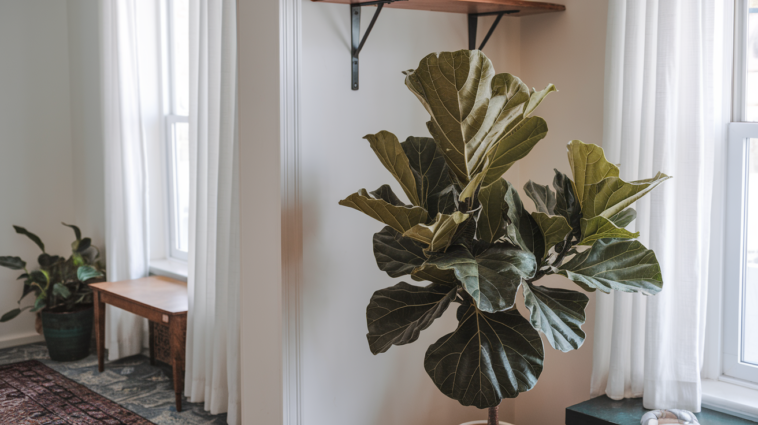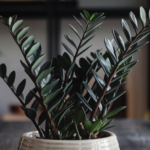I’m excited to share my knowledge on Fiddle Leaf Fig care. It’s all about growing a lush and healthy plant. Creating the perfect environment for your indoor plants, like Fiddle Leaf Figs, is key.
With the right care, you can enjoy these stunning houseplants at home. In this article, I’ll share essential tips. You’ll learn how to cultivate a thriving Fiddle Leaf Fig. It’s a great addition to your indoor plant collection.
Understanding Your Fiddle Leaf Fig: Basic Characteristics
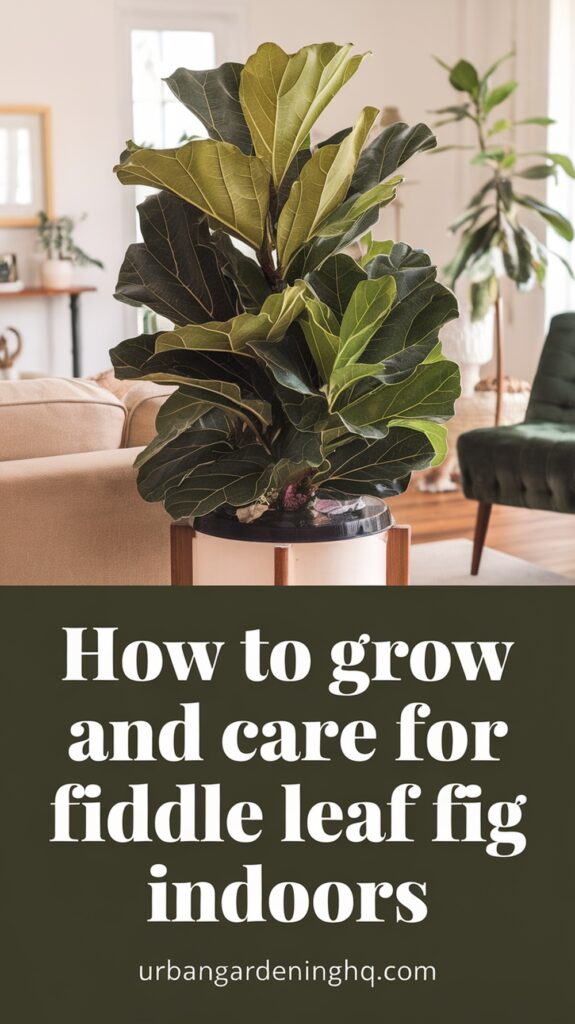
To grow a thriving Fiddle Leaf Fig, knowing its basics is key. These plants come from West Africa’s tropical areas. They have big, violin-shaped leaves and can reach up to 40 feet tall in the wild. This info helps you care for your plant right.
Fiddle Leaf Figs come in many varieties, each with its own look. You might have the ‘Compacta’, which is small and bushy, or the ‘Columnaris’, which is tall and slender. Knowing your plant’s growth pattern helps you meet its needs better.
Here are some key traits of Fiddle Leaf Fig varieties:
- Large, violin-shaped leaves with a glossy finish
- Ability to grow up to 40 feet tall in their natural habitat
- Compact and bushy or tall and slender growth patterns
- Adaptability to indoor environments, making them a popular choice for houseplants
Understanding these traits and growth patterns helps you care for your Fiddle Leaf Fig. Whether you’re new to plants or not, this knowledge makes enjoying your Fiddle Leaf Fig even better.
Creating the Perfect Growing Environment
As a fan of indoor plants, I know how key it is to mimic their natural home. For plants like the Fiddle Leaf Fig, this means creating a space that matches their native conditions. The perfect temperature for these plants is between 65-75°F (18-24°C). Humidity should be around 50-60%.
To get this right, you can use a humidifier or group plants together. This creates a microclimate that helps maintain the right humidity.
Air circulation is also vital to prevent fungal diseases. Make sure your Fiddle Leaf Fig has enough space around it. Keep it at least 6-8 inches away from walls or surfaces. Fans can also help move the air and prevent it from getting stale.
By controlling temperature, humidity, and air circulation, you can create a perfect environment for your houseplants. This will help them thrive.
Here are some tips to help you create the perfect growing environment for your Fiddle Leaf Fig:
- Use a thermometer to monitor the temperature and adjust as needed
- Invest in a humidifier to maintain the ideal humidity levels
- Provide good air circulation by keeping your plant away from walls and using fans
- Monitor your plant’s response to its environment and adjust as needed
By following these tips, you can create a thriving growing environment for your indoor plants, including your Fiddle Leaf Fig. Always watch how your plant reacts to its environment. Make changes as needed to keep it healthy and growing well.
| Environmental Factor | Ideal Condition |
|---|---|
| Temperature | 65-75°F (18-24°C) |
| Humidity | 50-60% |
| Air Circulation | Good air movement around the plant |
Essential Light Requirements for Healthy Growth
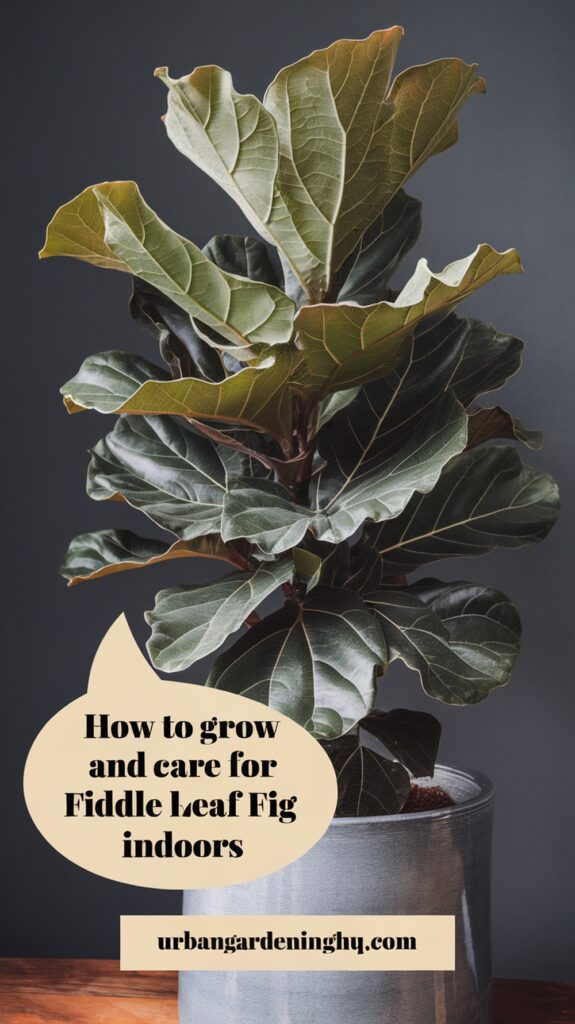
Understanding the light needs of a Fiddle Leaf Fig is key to its health. Light is vital for your plant’s growth. Most Fiddle Leaf Figs need bright, indirect light but can handle some direct sun. Make sure your plant gets the right light by considering both natural and artificial light.
Positioning your plant for natural light is important. East- or west-facing windows are best for indirect light. If natural light is scarce, artificial lights like grow lights can help. Adjust the light your plant gets with the seasons to meet its changing needs.
Optimal Lighting Conditions
- Place your plant near an east- or west-facing window for indirect light
- Use artificial light solutions such as grow lights if natural light is limited
- Adjust light requirements seasonally to ensure optimal growth
Knowing your Fiddle Leaf Fig’s light needs helps it thrive. Use both natural and artificial light to ensure it gets enough light to grow well.
| Light Type | Benefits |
|---|---|
| Natural Light | Promotes healthy growth, provides essential nutrients |
| Artificial Light | Supplements natural light, provides consistent lighting |
Watering Your Fiddle Leaf Fig Like a Pro
Watering your Fiddle Leaf Fig right is key. Too much water can cause root rot, while too little can make leaves fall off. To keep your plant healthy, you need to get the soil moisture just right. Stick your finger into the soil up to the first knuckle to check if it’s dry. If it is, it’s time to water.
Knowing how to water your Fiddle Leaf Fig is important. Here are some tips to help you water like a pro:
- Check the soil moisture regularly to avoid overwatering or underwatering.
- Water your plant when the top inch of soil feels dry to the touch.
- Avoid getting water on the leaves to prevent fungal diseases.
By following these tips and keeping the soil moisture right, you can give your Fiddle Leaf Fig the best care. Remember, watering is a big part of plant care. Getting it right is key to keeping your plant happy and healthy.
| Watering Tips | Benefits |
|---|---|
| Check soil moisture regularly | Prevents overwatering and underwatering |
| Water when top inch of soil is dry | Ensures plant receives right amount of water |
| Avoid getting water on leaves | Prevents fungal diseases |
Soil and Fertilization Requirements
To make sure your Fiddle Leaf Fig grows well, knowing about soil and fertilization is key. A potting mix that drains well and is full of organic matter is best. It gives your plant the nutrients it needs to grow strong.
For fertilizing, use a balanced, water-soluble fertilizer. It’s important to fertilize regularly but not too much.
Here are some important points to remember:
- Soil pH balance: keeping the right pH is important for your plant to absorb nutrients well.
- Fertilization types: pick a fertilizer with nitrogen, phosphorus, and potassium to help your plant grow.
- Soil testing: testing your soil regularly helps you know the best pH and nutrients for your Fiddle Leaf Fig.
By knowing about soil and fertilization, you can help your Fiddle Leaf Fig grow strong. For more tips on caring for your plant, check out the fiddle leaf fig transplanting guide.
Pruning and Shaping Techniques
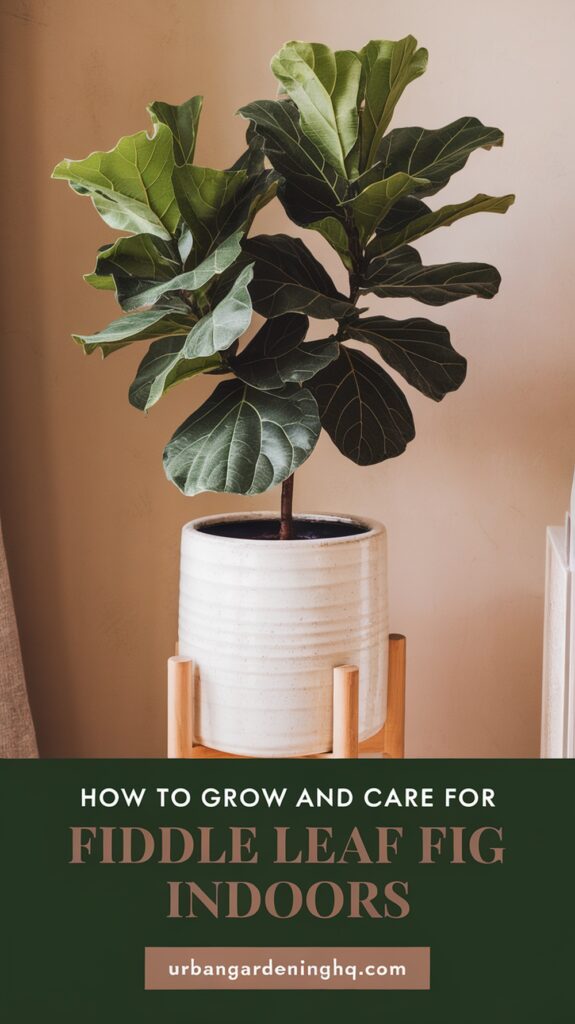
As a fiddle leaf fig owner, I know how key pruning and shaping are. They keep the plant healthy and looking good. Pruning gets rid of dead or damaged parts, stopping disease and encouraging new growth. The best time for pruning is spring and summer when the plant is growing fast.
Shaping is important too, but be careful not to cut too much. It helps keep the plant looking the way you want and promotes healthy growth. Regular pruning and shaping keep your fiddle leaf fig looking great and thriving.
Here are some tips for pruning and shaping your fiddle leaf fig:
- Use clean, sharp tools to avoid spreading disease
- Take out dead or damaged leaves and branches for better growth
- Shape the plant to your liking, but don’t overdo it
By following these tips, you can make your fiddle leaf fig flourish. Enjoy its beautiful, lush leaves for many years.
Common Problems and Solutions
As a Fiddle Leaf Fig owner, I’ve faced many issues. Leaf dropping is a big one, often due to too much or too little water, or sudden changes in temperature or humidity. To solve these problems, keeping your plant clean, ensuring good air flow, and not overwatering are key. These steps are vital for keeping your plant healthy.
It’s important to check your plant for pests like spider mites, mealybugs, and scale often. Catching these early can save your plant. Organic pest control methods are a good way to fight pests. For more tips, check out this resource on herbs for migraine relief. It also has great advice on plant care.
Here are some common problems and how to fix them:
- Leaf dropping: Check your plant’s watering schedule and adjust as needed to prevent overwatering or underwatering.
- Disease: Maintain good hygiene, provide adequate air circulation, and avoid overwatering to prevent disease.
- Pests: Regularly inspect your plant for pests and use organic pest control methods to prevent infestations.
Knowing these common problems and how to prevent them can help your Fiddle Leaf Fig thrive. With the right care, it will bring beauty to your space for years.
Propagation Methods for Your Fiddle Leaf Fig
As I care for my Fiddle Leaf Fig, I’ve grown interested in propagation. It’s a way to make new plants from old ones. This is perfect for sharing with friends or growing your collection. You can use stem cutting or air layering, both effective methods.
Understanding the different propagation methods is key. Stem cutting means taking a stem section and rooting it in water or soil. It needs the right light, water, and nutrients. Air layering, on the other hand, involves making a cut in the stem and using moist moss to grow roots.
Techniques for Successful Propagation
- Stem cutting: Cut a 4-6 inch section of stem, remove lower leaves, and root in water or soil.
- Air layering: Make a small incision in the stem, wrap in moist sphagnum moss, and wait for roots to develop.
- Caring for new plants: Provide adequate light, water, and nutrients to ensure healthy growth.
By using these techniques and giving the right care, you can grow your Fiddle Leaf Fig. Make sure to research your plant’s needs. If you need help, experts or online resources are great resources. With time and effort, you’ll master propagation and enjoy sharing your plants.
| Propagation Method | Description | Success Rate |
|---|---|---|
| Stem Cutting | Cut a section of stem and root in water or soil | 70-80% |
| Air Layering | Make a small incision and wrap in moist sphagnum moss | 60-70% |
Conclusion: Nurturing Your Plant to Success
Starting your journey with a Fiddle Leaf Fig requires patience and dedication. Follow the expert plant care tips in this guide. This will help your plant thrive for a long time. Always watch your plant’s health and make changes when needed.
Your Fiddle Leaf Fig can become a beautiful part of your home with the right care. Enjoy the journey and celebrate your plant’s growth. Your dedication and care are what make it successful.
